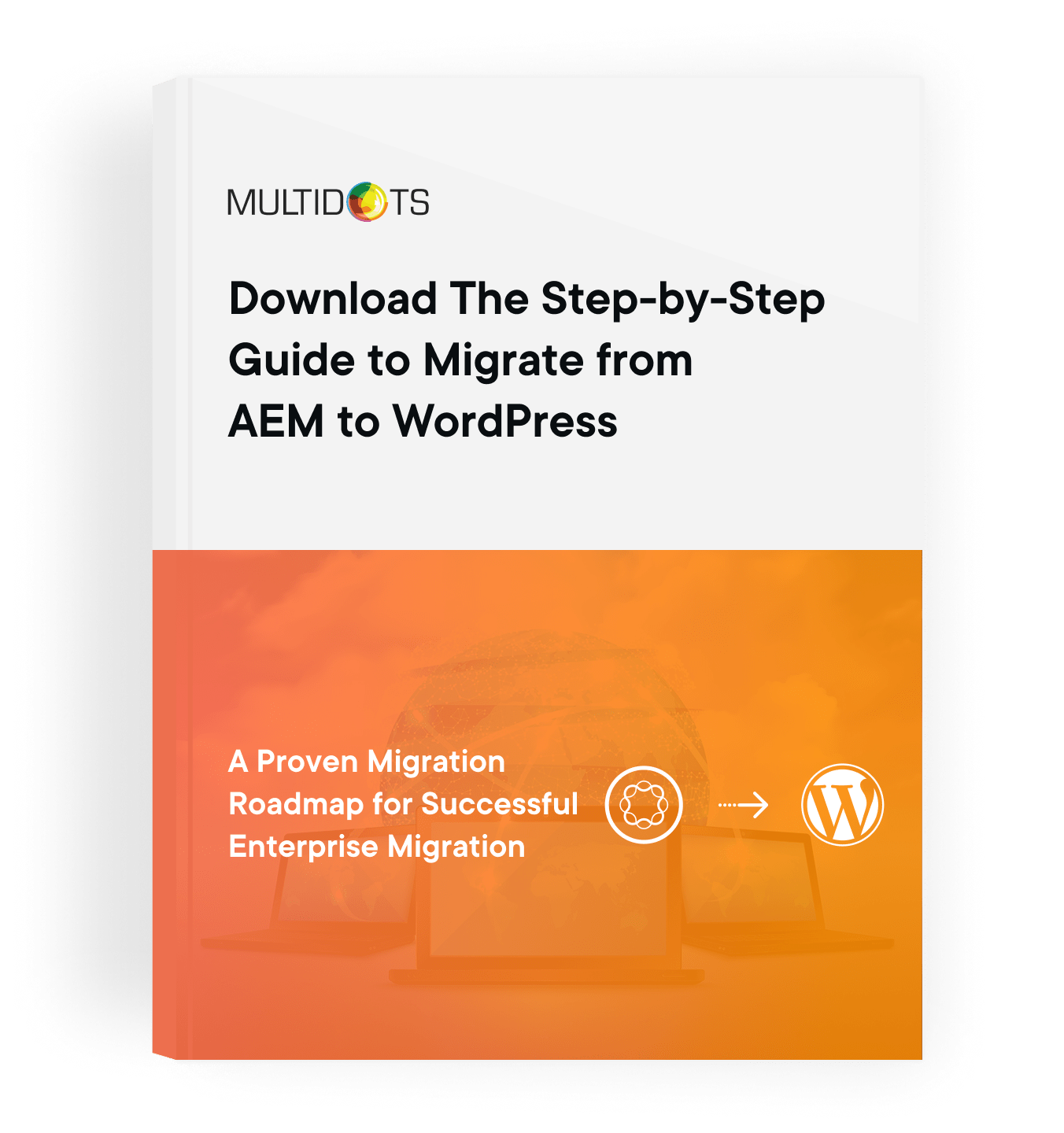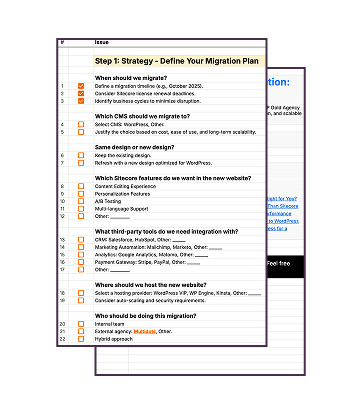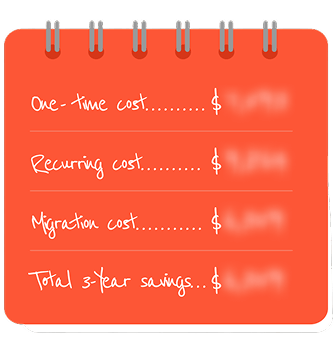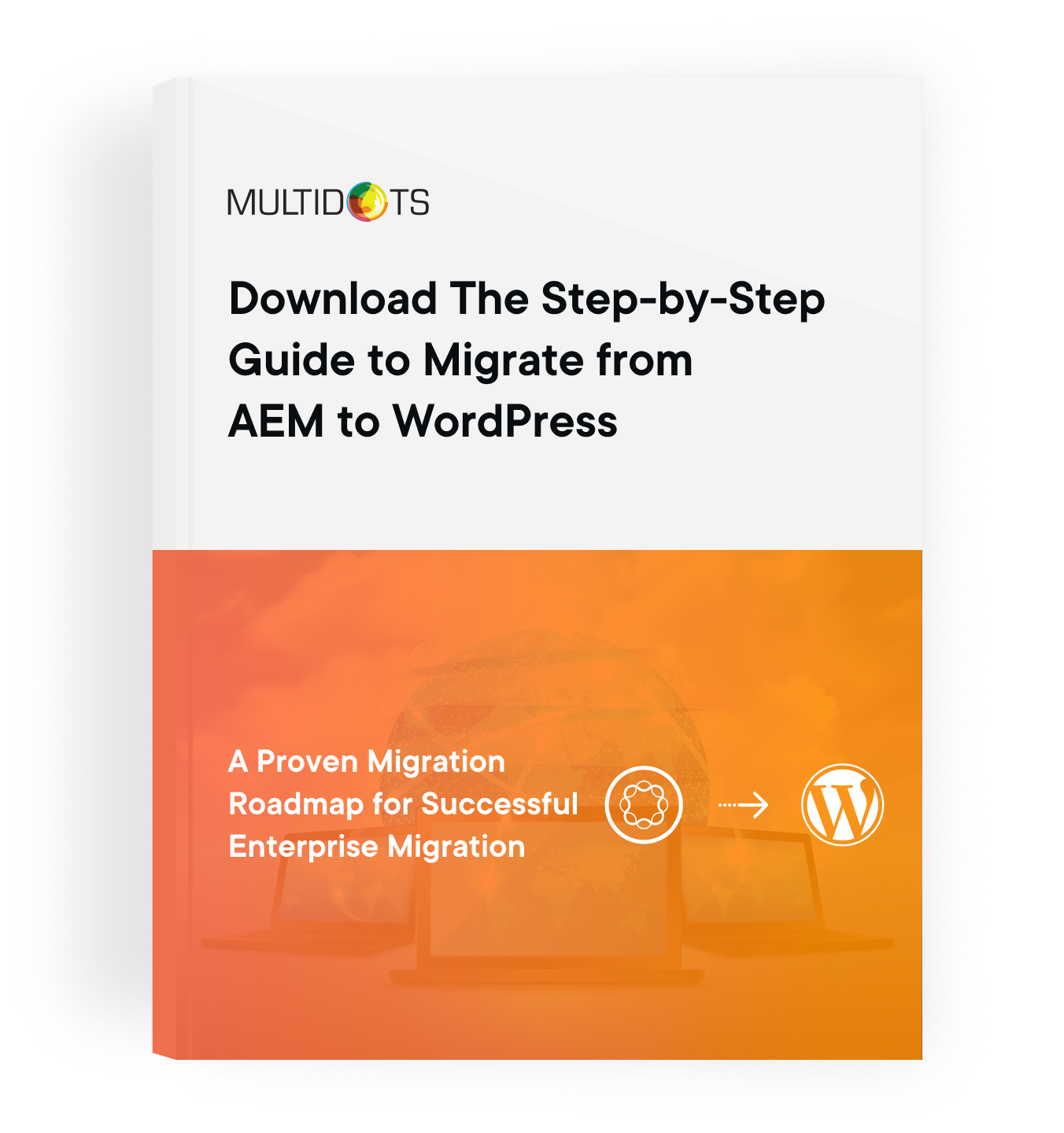The Ultimate Step-by-Step Guide to Migrate from AEM to WordPress
Learn how to seamlessly migrate from Adobe Experience Manager to WordPress with our comprehensive enterprise migration guide
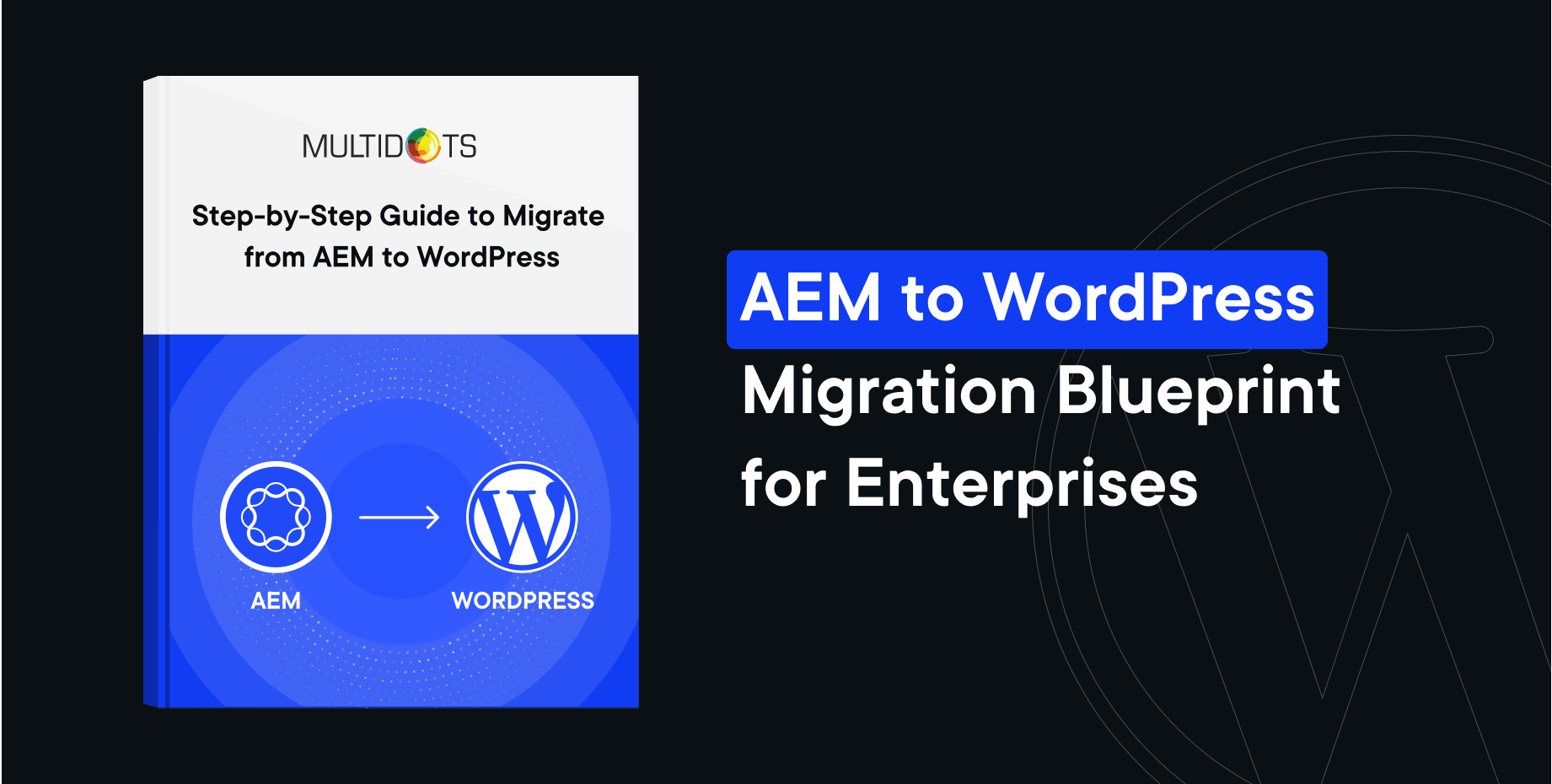
Table of Contents
So, you're evaluating a move from Adobe Experience Manager to WordPress. Smart thinking!
Whether you're here because AEM's licensing costs are eating into your budget, your content team is frustrated with complex workflows, or you're simply exploring more flexible alternatives, you've come to the right place.
This isn't just another "how-to" guide. It's a complete roadmap built from real enterprise migration experience, covering everything from strategic planning to post-launch optimization.
We know AEM migrations are complex—that's exactly why we've created this comprehensive resource.
Here's how to navigate this guide quickly to get straight to the answers you're looking for:
- Start here if you want to discover the business benefits and cost savings of migrating to WordPress for your technical, editorial, and marketing teams.
- Start here for a deep dive into the ROI and comprehensive cost comparison between WordPress and AEM.
- Start here if you want to address common concerns people often have about AEM to WordPress migration.
- Start here for a step-by-step guide on how to handle the migration yourself.
- Start here if you have specific questions about your unique migration needs.
- Start here to download this guide as a PDF—perfect for your next flight or to share with your team.
Or skip all of that and schedule a free 30-minute consultation with us. Let's cut to the chase and tackle your questions head-on.
So, what are you waiting for?
Dive in, find the answers you need, and let's get started on this journey together!
WHY YOU SHOULD MIGRATE FROM AEM TO WORDPRESS
If you're already convinced to migrate from AEM to WordPress, feel free to jump ahead to the section — How to Migrate.
However, if you want to explore the compelling reasons and benefits for making this strategic move, read on.
The Business Case for Migration
Migrating from AEM to WordPress isn't just a platform switch—it's a strategic business decision that impacts your bottom line, team productivity, and digital agility. Let's look at why enterprise organizations are increasingly choosing WordPress over AEM.
Here's an approximate side-by-side cost comparison between AEM and WordPress for a large-scale enterprise website:
| Cost | WordPress | AEM (On-Premise) | AEM Managed Services | AEM as Cloud Service (AEMaaCS) |
|---|---|---|---|---|
| License Cost (Annual) | $0 | $250,000 to $350,000 | $300,000 to $500,000 | $500,000 to $700,000 |
| Design and Build (One-time) | $50,000 to $100,000 | $400,000 to $600,000 | $300,000 to $500,000 | $300,000 to $500,000 |
| Cloud and Hosting (Annual) | $25,000+ | $200,000 | $0 | $0 |
| Average Cost of 5 Premium Add-ons (Annual) | $25,000+ | $200,000+ | $100,000+ | $100,000+ |
| Support and Maintenance (Annual) | $12,000 to $24,000 | $150,000 to $300,000 | $100,000 to $200,000 | $50,000 to $150,000 |
| Non-Production Installations (Annual) | $0 | $50,000 to $75,000 | $0 | $0 |
| Total Cost (1st Year) | $100K to $180K | $1.25M to $1.75M | $800K to $1.25M | $1M to $1.5M |
| Total Cost (3 Years) | 🏆 $200K to $350K | $3.25M to $4M | $2M to $3M | $2.5M to $4M |
Note: These estimates are based on a website with approximately 1 million monthly visitors. All amounts are in USD, reflecting pricing data as of October 2024.
The numbers speak for themselves. WordPress delivers enterprise-grade capabilities at a fraction of AEM's cost, freeing up resources for innovation and growth initiatives.
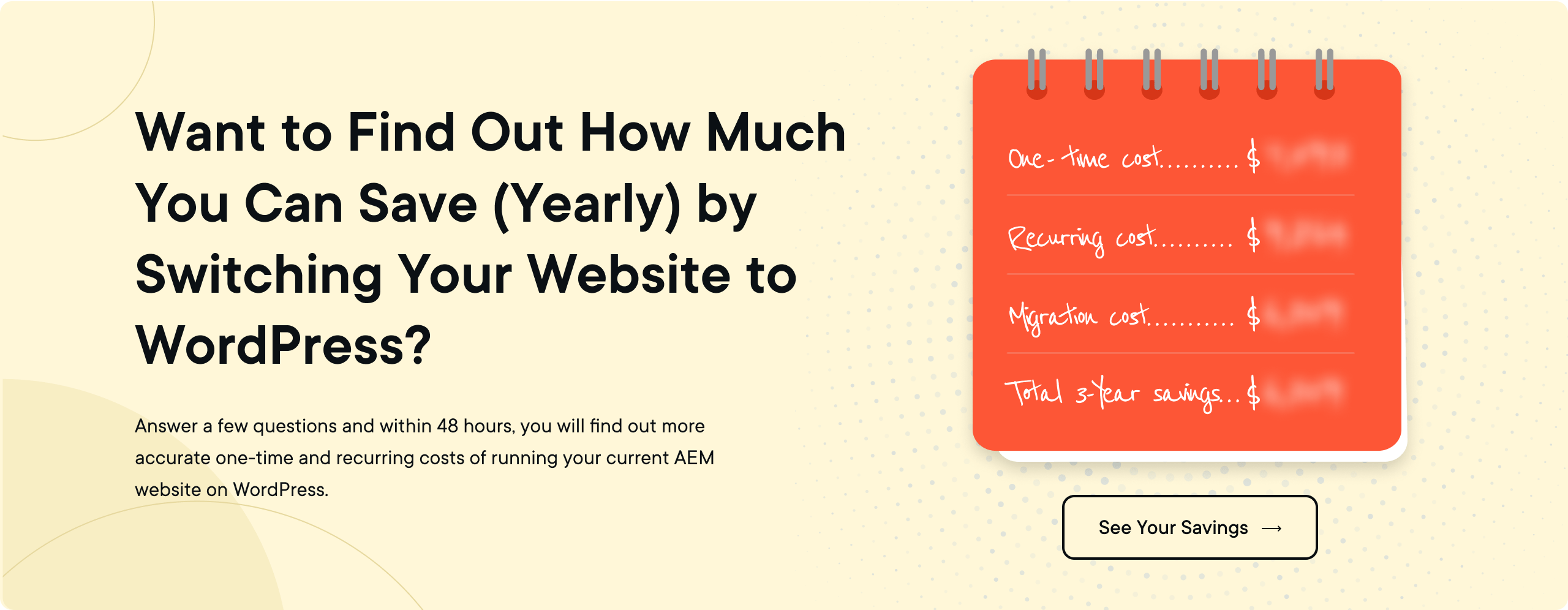
Benefits of Migrating from AEM to WordPress
When you migrate from AEM to WordPress, you're not just changing platforms—you're transforming how your teams work. Here's how different departments benefit:
| Benefits | Technical Teams | Editorial Teams | Marketing Teams |
|---|---|---|---|
| Productivity | Faster development with extensive plugin ecosystem and familiar PHP stack | Intuitive Gutenberg editor speeds up content creation and reduces training time | Built-in SEO tools and marketing integrations accelerate campaign deployment |
| Customization | Flexible architecture with thousands of plugins and unlimited customization potential | Custom content blocks and templates without developer dependency | Advanced personalization through dynamic content and marketing automation |
| Cost-Effectiveness | No licensing fees, abundant developer talent, and lower infrastructure costs | Minimal training required with user-friendly interface | Cost-effective marketing tools with better ROI tracking |
| Flexibility | Open-source freedom, multiple hosting options, and vendor independence | Easy collaboration with role-based permissions and approval workflows | Seamless integration with CRMs, analytics, and marketing platforms |
| Innovation | Rapid feature deployment and access to cutting-edge web technologies | Modern editing experience with real-time collaboration features | Advanced marketing capabilities through WordPress's extensive ecosystem |
Why AEM Might Be Holding You Back
Don't get us wrong, Adobe Experience Manager is a powerful platform. But for many organizations, its complexity and cost structure create more challenges than solutions.
1. High Total Cost of Ownership
AEM's enterprise pricing goes beyond licensing fees. You're looking at specialized developer costs (those Adobe-certified developers don't come cheap), complex infrastructure requirements, and ongoing maintenance expenses that can spiral quickly. Many organizations find themselves paying for capabilities they rarely use while struggling to justify the ROI.
2. Vendor Lock-in Challenges
Once you're in the Adobe ecosystem, every additional feature comes with an Adobe-level price tag. Need form functionality? That's AEM Forms. Want better analytics? Hello, Adobe Analytics. This creates a dependency that limits your flexibility and inflates costs over time.
3. Complexity That Slows You Down
AEM's architecture, while robust, often introduces unnecessary complexity for everyday content management tasks. Your content teams shouldn't need a computer science degree to publish a blog post, and your developers shouldn't spend hours configuring simple features.
If You Still Have Any Concerns on Switching From AEM to WordPress? Let’s Address Them:
Migrating from one enterprise CMS to another is a significant decision, and naturally, you have questions and concerns. If you're considering moving from AEM to WordPress, you might be wondering if it's the right fit for your organization's complex needs.
Let's address the most common concerns we hear from enterprise teams:
1. "Can WordPress handle our enterprise scale and traffic volumes?"
Absolutely! WordPress powers some of the world's highest-traffic websites, including The New York Times, CNN, and Microsoft News. With proper architecture and enterprise hosting solutions like WordPress VIP, your site can handle millions of visitors without breaking a sweat.
The key is pairing WordPress with the right infrastructure. Enterprise hosting providers offer auto-scaling, global CDNs, and performance optimization that rivals or exceeds what most AEM implementations can achieve. Plus, you'll have more flexibility in choosing hosting solutions that fit your specific performance and budget requirements.
2. "What about AEM's advanced Digital Asset Management capabilities?"
While AEM's DAM is sophisticated, WordPress offers robust media management that meets most enterprise needs. Through plugins like WP Media Folder, FileBird, and integration with external DAM solutions like Cloudinary or ImageKit, you can replicate and often improve upon AEM's asset management capabilities.
For organizations with complex DAM requirements, WordPress integrates seamlessly with dedicated DAM solutions, giving you the flexibility to choose best-in-class tools rather than being locked into Adobe's ecosystem.
3. "How will WordPress replicate our complex content workflows?"
WordPress excels at editorial workflows through plugins like PublishPress, Edit Flow, and custom workflow solutions. You can create approval processes, editorial calendars, and collaborative editing environments that often surpass AEM's workflow capabilities in terms of user experience and flexibility.
The beauty of WordPress workflows is their adaptability—you can modify and scale them as your organization evolves without requiring expensive developer resources or lengthy implementation timelines.
4. "Can WordPress support our multi-site, multi-language setup?"
WordPress Multisite functionality, combined with plugins like WPML, Polylang or MultilingualPress, provides robust multi-site and multilingual capabilities. Many enterprise organizations successfully manage dozens or even hundreds of sites through WordPress Multisite networks.
The centralized management, shared resources, and simplified maintenance often make WordPress multisite implementations more efficient than managing multiple AEM instances.
5. "What happens to our Adobe ecosystem integrations?"
While you might lose direct Adobe ecosystem integration, WordPress offers superior flexibility in choosing best-of-breed solutions. Instead of being locked into Adobe Analytics, you can choose from Google Analytics, Adobe Analytics (still possible), or specialized analytics platforms that better fit your needs.
WordPress's open architecture and extensive API capabilities mean you can integrate with virtually any third-party service, often with better performance and lower costs than Adobe's bundled solutions.
6. "Is WordPress secure enough for enterprise requirements?"
When properly configured and maintained, WordPress is extremely secure. Enterprise hosting providers implement advanced security measures including DDoS protection, malware scanning, and automatic security updates. The platform's popularity also means security vulnerabilities are quickly identified and patched.
Many Fortune 500 companies trust WordPress with their most critical web properties, and with proper security protocols, it can meet the most stringent enterprise security requirements.
7. "How complex is the migration process and timeline?"
Migration complexity depends on your current AEM implementation, but most enterprise migrations can be completed in 12-16 weeks. The process involves careful planning, content mapping, and phased implementation to minimize disruption.
With experienced migration partners, you can maintain business continuity while transitioning to a more flexible and cost-effective platform. The investment in migration typically pays for itself within the first year through reduced licensing and operational costs.
8. "Will we lose our content personalization capabilities?"
WordPress offers sophisticated personalization through plugins and integrations that often exceed AEM's native capabilities. Solutions like Dynamic Content for Elementor, PersonalizeWP, or integration with marketing automation platforms can deliver highly targeted content experiences.
The advantage with WordPress is choice—you can select personalization tools that exactly match your needs and budget rather than paying for an entire suite of features you might not use.
HOW TO MIGRATE FROM AEM TO WORDPRESS
You've made the decision to move from AEM to WordPress—excellent choice! Now comes the exciting part where we transform that decision into action.
In the following sections, we'll walk you through each step of the migration process, from initial strategy to post-launch optimization. Migration doesn't have to be intimidating. With the right approach and proper planning, you can ensure a smooth transition that preserves your content, maintains your SEO equity, and sets you up for success on your new WordPress platform.
Let's break down this process into manageable steps and get started with the most critical phase: strategy.
STEP 1: HIGH-LEVEL MIGRATION STRATEGY
Before diving into technical details, let's map out a strategic approach to ensure your migration is successful. A well-planned migration strategy will save you time, resources, and potential headaches down the road.
1.1 When should we migrate?
Timing is everything when it comes to migrating your enterprise website. The right moment isn't just about technical readiness—it's about business alignment too.
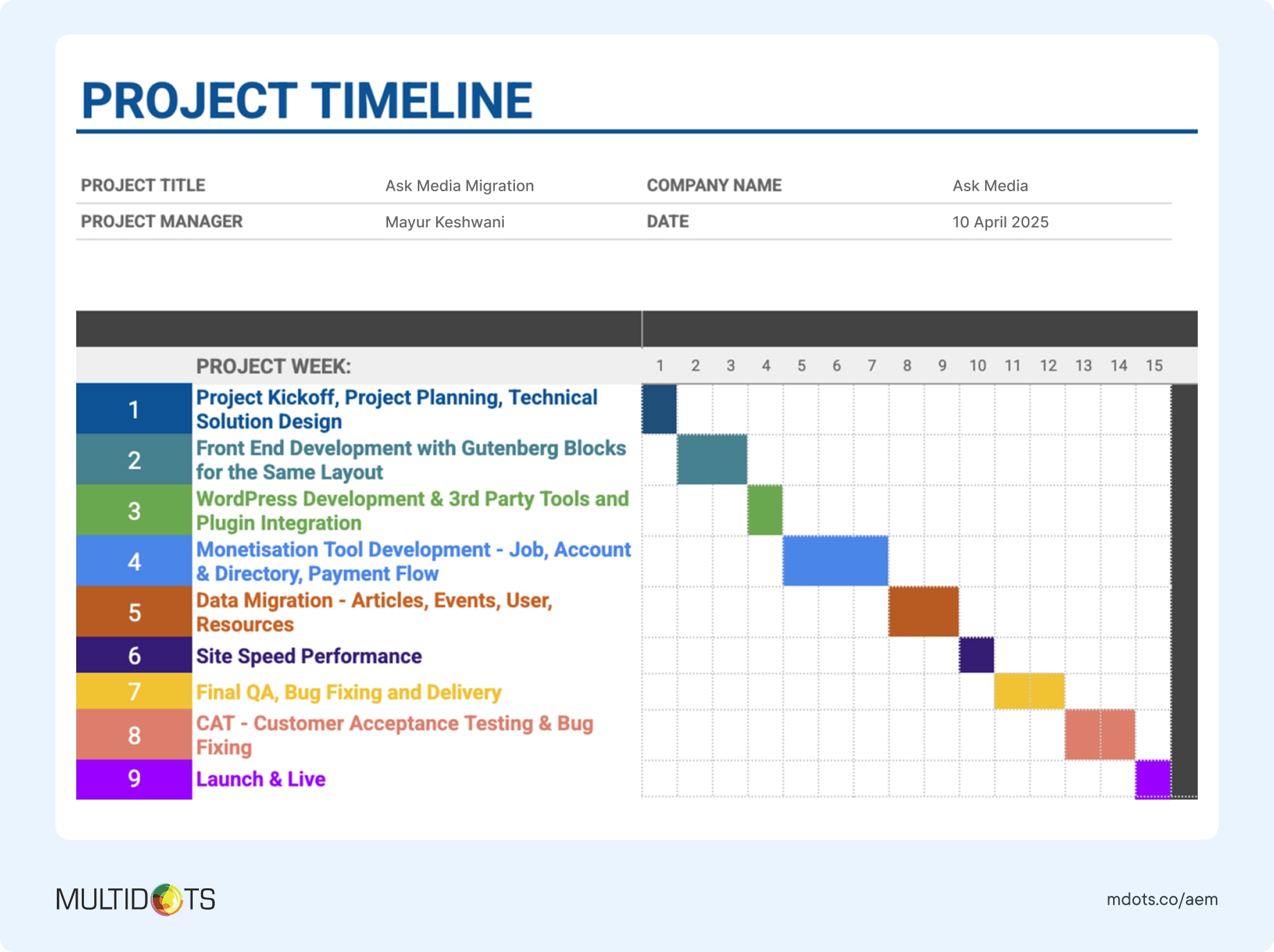
Here are clear signals that it's time to consider migrating from AEM to WordPress:
- License renewal approaching: If your AEM license is up for renewal in the next 3-6 months, it's the perfect time to evaluate alternatives before committing to another expensive year.
- Escalating maintenance costs: When your AEM implementation requires increasingly expensive Adobe-certified developers or consultants for routine tasks.
- Publishing bottlenecks: Content creators constantly waiting for developer assistance or facing workflow delays that impact time-to-market.
- Scalability challenges: Your business is growing, but your AEM implementation struggles to scale cost-effectively.
- Integration limitations: Difficulty integrating with non-Adobe tools or requiring expensive custom development for basic functionality.
Enterprise-grade migrations typically take 12-16 weeks depending on your website's complexity, content volume, and customization needs. The key is to start planning well before you face critical deadlines or technical emergencies.
1.2 Which CMS should we migrate to?
While you're likely already considering WordPress since you're reading this guide, let's confirm why it's often the best choice for enterprises moving away from AEM.
WordPress powers over 43% of all websites on the internet, including enterprise sites for companies like Microsoft, Sony Music, The Walt Disney Company, and Bloomberg Professional. This massive adoption isn't accidental—it comes from delivering exceptional value and capabilities.
Here's a quick features comparison of WordPress vs AEM (and other CMS - Sanity and Sitecore):
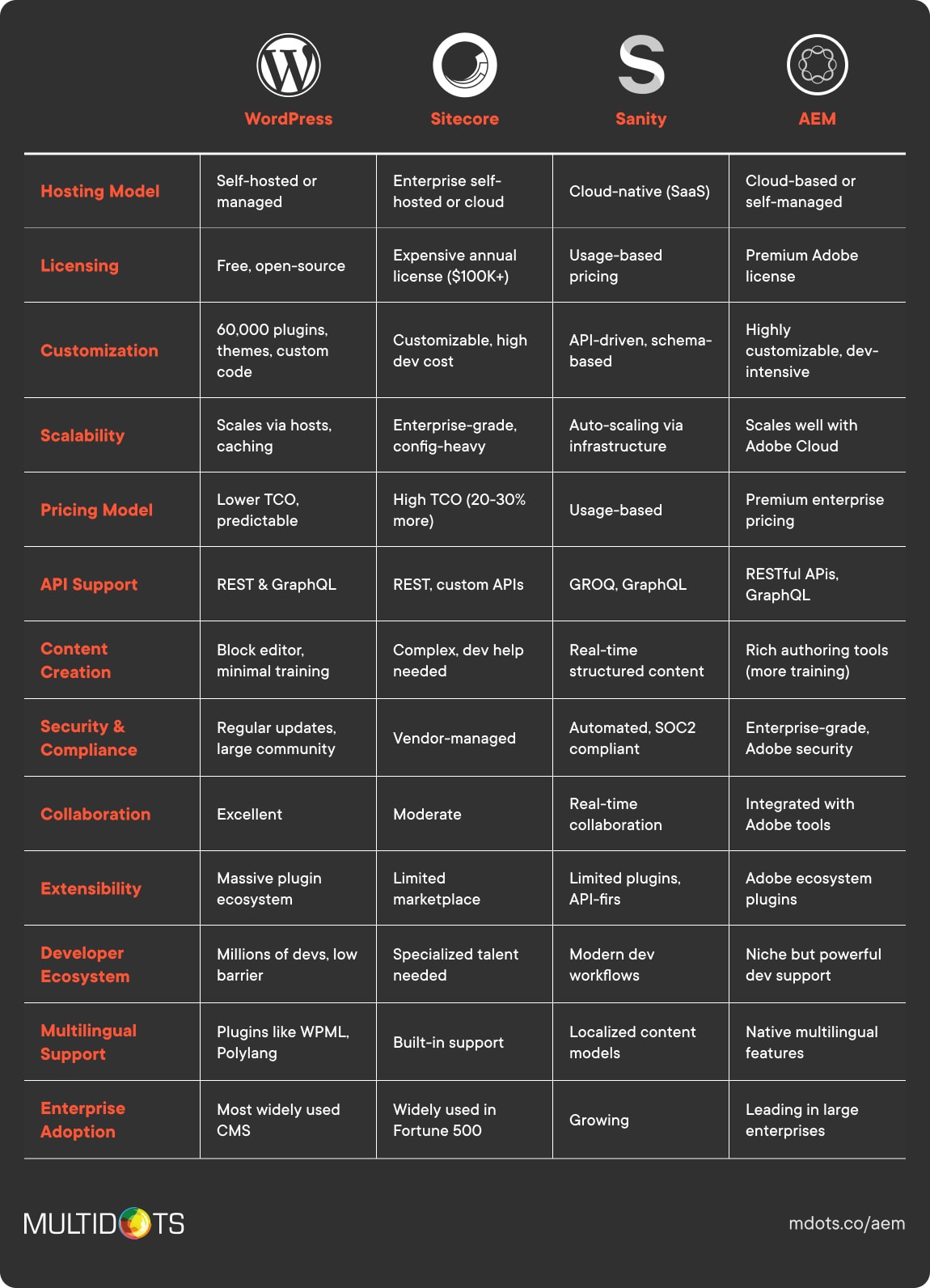
Here's why WordPress stands out as the top alternative to AEM:
- WordPress eliminates expensive licensing fees while providing enterprise-grade capabilities.
- You get the flexibility of open-source software with the reliability of enterprise hosting solutions.
- The vast talent pool means you're not dependent on specialized, expensive Adobe-certified developers.
- Plus, WordPress evolves rapidly with thousands of contributors ensuring you stay ahead of web technology trends.
1.3 Design strategy: refresh or replicate?
When migrating from AEM to WordPress, you have two primary design approaches: maintain your current design or take the opportunity to refresh it. Both have their merits depending on your circumstances.
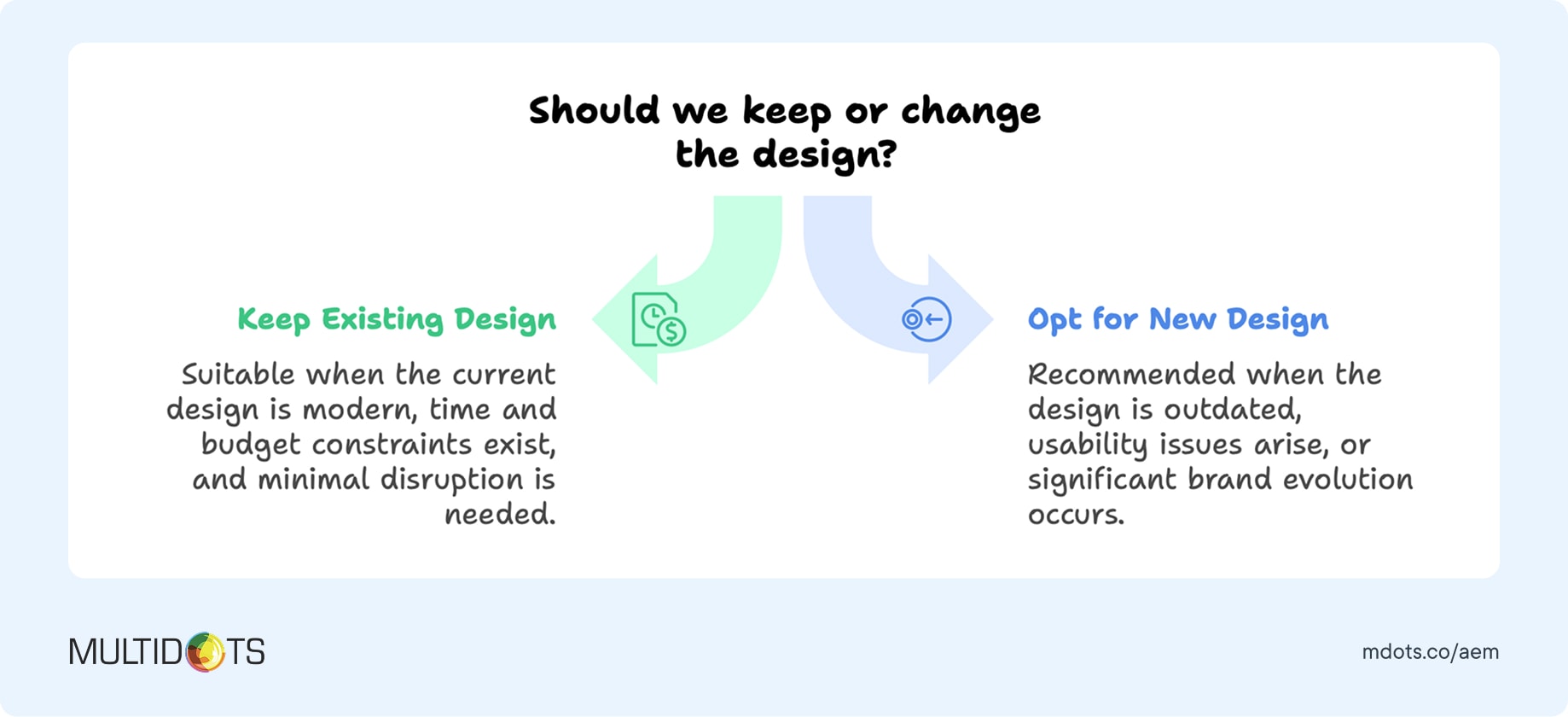
Keeping your current design makes sense when you have a recently updated design that performs well, want to minimize migration complexity, have tight timeline constraints, or need to maintain brand consistency during the transition. This approach typically reduces migration time by 20-30% and helps users adapt more easily to the new platform.
Refreshing your design is ideal when your current design is outdated, you want to improve user experience, you're planning to add new functionality, or you want to fully leverage WordPress's modern capabilities. A refresh can improve conversion rates, enhance mobile experience, and better align with current web standards.
Many successful migrations take a hybrid approach—keeping the overall brand identity while updating specific components for better performance and user experience.
1.4 AEM feature analysis and WordPress mapping
Understanding which AEM functionalities are essential to your business operations is crucial. This ensures you don't lose critical capabilities while avoiding unnecessary complexity in your WordPress implementation.
Let's map the most common AEM features to their WordPress alternatives:
- Digital Asset Management (DAM): WordPress Media Library combined with plugins like WP Media Folder or integration with Cloudinary provides robust asset management. For advanced DAM needs, WordPress integrates seamlessly with dedicated solutions.
- Experience Fragments: WordPress Gutenberg's reusable blocks and template parts offer similar functionality with even greater flexibility for content creators.
- Multi-site Management: WordPress Multisite provides centralized management for multiple sites with shared resources and simplified maintenance.
- Content Workflows: Plugins like PublishPress Pro and Edit Flow create sophisticated editorial workflows that often exceed AEM's capabilities in user experience.
- Forms Management: Gravity Forms, WPForms, or Contact Form 7 provide advanced form functionality without the additional licensing costs of AEM Forms.
- Personalization: Dynamic content plugins and marketing automation integrations deliver targeted experiences that rival AEM's personalization engine.
Before you begin the migration process, create a comprehensive list of AEM features you're actively using and prioritize them from "mission-critical" to "nice-to-have." This will help focus your migration efforts on the most important capabilities first.
1.5 Third-party integration planning
Your website doesn't exist in isolation—it's part of a broader technology ecosystem. Mapping your existing integrations ensures business continuity and seamless data flow between systems.
Here's how common AEM integrations translate to WordPress:
| Integration Category | Common AEM Tools | WordPress Solutions | Key Benefits |
|---|---|---|---|
| CRM Systems | Salesforce, HubSpot, Microsoft Dynamics | Dedicated WordPress plugins, REST API connections | Better performance than AEM integrations, more flexible data sync options |
| Marketing Automation | Marketo, Pardot, MailChimp, Adobe Campaign | WordPress plugins, native connectors | More flexibility in campaign management and lead tracking, easier setup |
| Analytics Platforms | Adobe Analytics, Google Analytics, Adobe Target | Enhanced WordPress integrations, specialized analytics tools | Deeper insights than AEM implementations, better reporting capabilities |
| E-commerce Solutions | Adobe Commerce, third-party platforms | WooCommerce, Shopify, BigCommerce integrations | Native WordPress e-commerce or flexible platform connections AEM can't match |
| Payment Gateways | Adobe bundled solutions, enterprise processors | Stripe, PayPal, Square, enterprise gateways | Lower transaction fees than Adobe's bundled solutions, more payment options |
| Content Delivery | Adobe CDN, enterprise CDNs | Cloudflare, AWS CloudFront, specialized CDNs | Better performance optimization, cost-effective global delivery |
| Email Marketing | Adobe Campaign, enterprise email tools | Mailchimp, Constant Contact, SendGrid | Simplified campaign creation, better automation workflows |
| Social Media | Adobe Social, third-party connectors | Native social plugins, API integrations | Easier social media management, real-time posting capabilities |
| Form Management | AEM Forms (additional license required) | Gravity Forms, WPForms, Contact Form 7 | No additional licensing fees, more form customization options |
| Search & Discovery | Adobe Search, enterprise search tools | WordPress native search, Elasticsearch, Algolia | Better search performance, more relevant results |
WordPress's open architecture provides several key benefits over AEM's integration approach:
- Lower Costs: No additional licensing fees for most integrations
- Faster Implementation: Plugins and APIs reduce development time
- Better Support: Large community provides extensive documentation and troubleshooting
- More Options: Choose best-of-breed solutions rather than being locked into Adobe ecosystem
- Easier Maintenance: Simpler integration architecture reduces ongoing maintenance complexity
- Better Performance: Optimized WordPress integrations often outperform AEM's complex integration layer
During your planning phase, inventory all current integrations, assess their importance to business processes, and identify WordPress alternatives. This preparation will streamline the migration process and ensure no critical connections are lost.
1.6 Enterprise hosting strategy
Selecting the right hosting provider is crucial for your WordPress website's performance, security, and reliability. For enterprises migrating from AEM, you need a solution that can handle high traffic volumes, complex functionality, and mission-critical reliability.
Here are a few top enterprise WordPress hosting options:
| Hosting Provider | Best For | Price Range (as of April 2025) | Key Features |
|---|---|---|---|
| WordPress VIP | Large enterprises with critical performance needs | Starting ~$25K/year | Highest-tier security, unlimited scaling, dedicated support team |
| WP Engine | Mid to large organizations balancing performance & cost | $600-$5K+/month | Excellent performance, dev/staging setup, automated backups |
| Pantheon | Organizations with active development needs | $500-$10K+/month | Google Cloud infrastructure, extensive global reach |
| Kinsta | Performance-focused businesses with moderate traffic | $400-$2K+/month | Excellent developer tools, git workflow, multi-environment testing |
| Pagely | Enterprise sites with custom needs | $500/month-custom pricing | VPS-based, highly customizable, excellent security |
When evaluating hosting providers, consider both your current needs and future growth. Essential features for enterprise WordPress hosting include automated backups and disaster recovery, staging and development environments, enterprise-grade security measures, dedicated support teams, scalable infrastructure, and performance optimization tools.
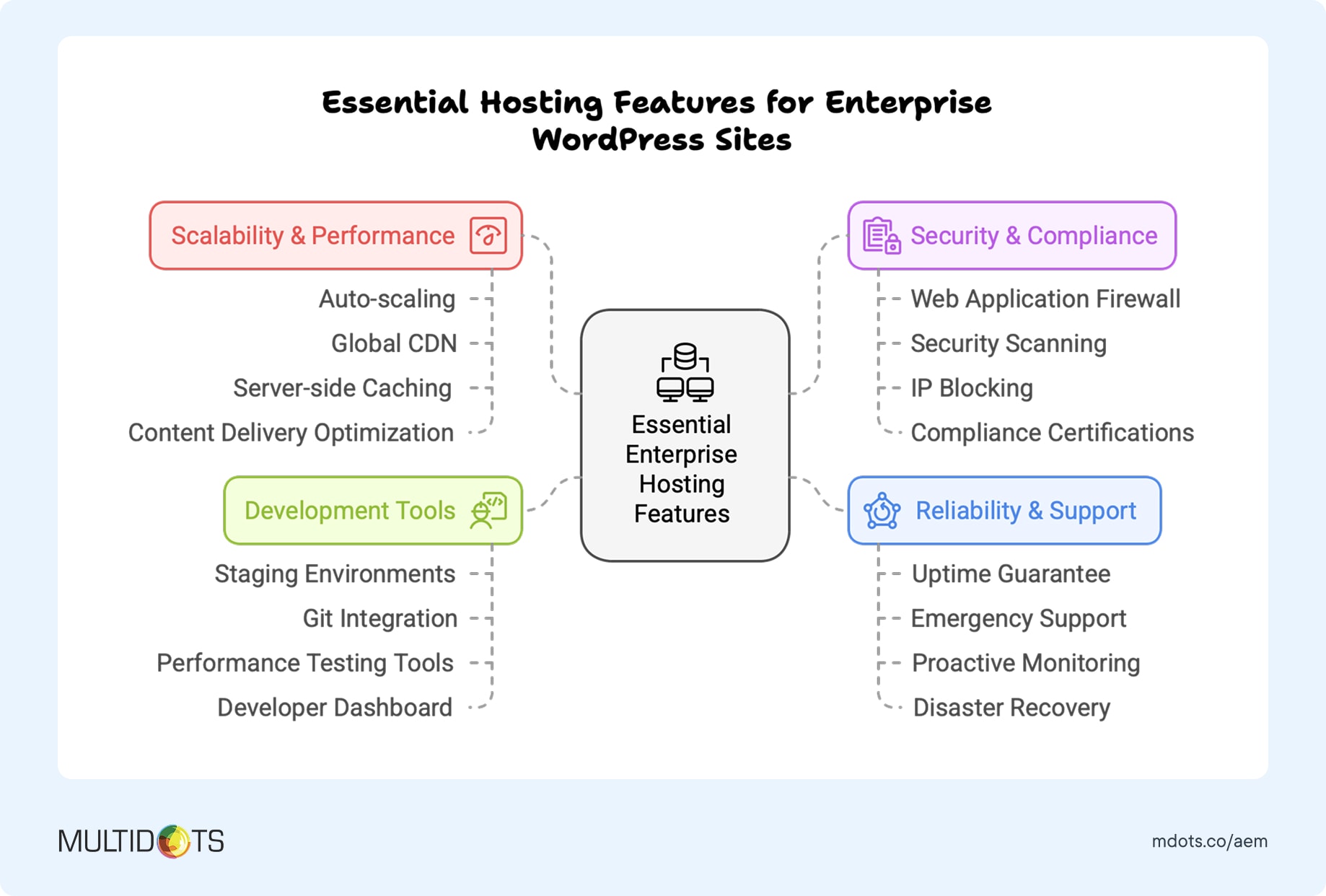
1.7 Migration team: internal vs external expertise
Deciding whether to handle your AEM to WordPress migration internally or engage external experts depends on your team's expertise, available resources, project timeline, and the complexity of your current AEM implementation.
Here's how you can decide between DIY vs when to hire a WordPress migration expert:
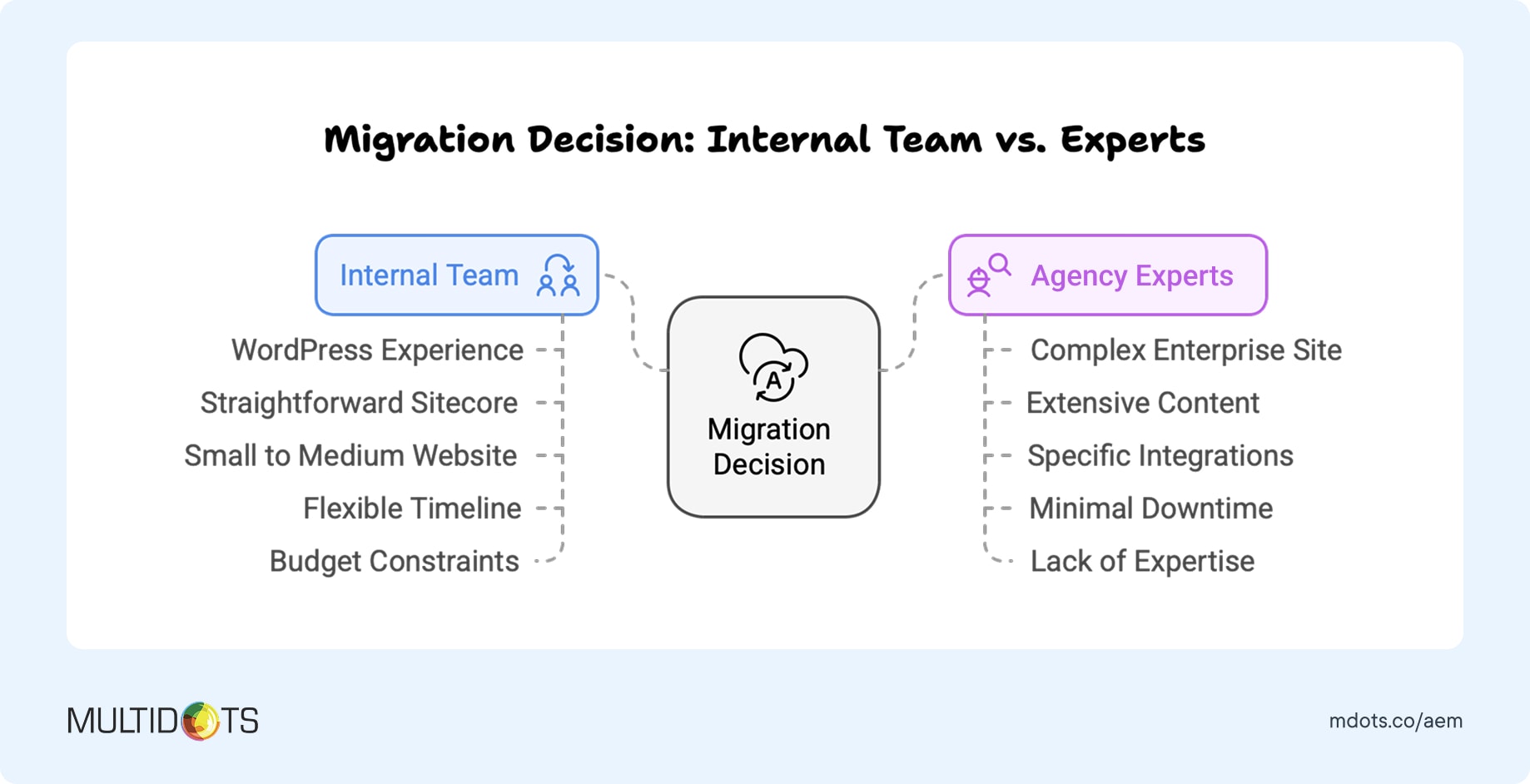
Internal migration makes sense when you have experienced WordPress developers on staff, have a relatively simple AEM implementation, can dedicate team members full-time to the project, and have flexibility in your timeline. However, consider that AEM migrations involve unique challenges that your team may not have encountered before.
External experts are recommended when you have a complex AEM implementation with custom components, are working with tight deadlines, lack WordPress expertise internally, or want to minimize business risk. Experienced migration partners can often complete projects faster and with fewer complications than internal teams.
Hybrid approach often provides the best results, where migration experts handle technical aspects and content transfer while your internal team contributes domain knowledge and specific requirements. This collaboration leverages outside expertise while building internal capabilities for long-term WordPress success.
If you decide to work with external experts, look for agencies with proven AEM to WordPress migration experience. At Multidots, we have extensive experience with complex AEM to WordPress migrations, specializing in enterprise organizations and large-scale digital transformations.
As a WordPress VIP Gold Partner, we adhere to the highest standards of WordPress development and security practices while bringing deep expertise in both AEM and WordPress platforms.
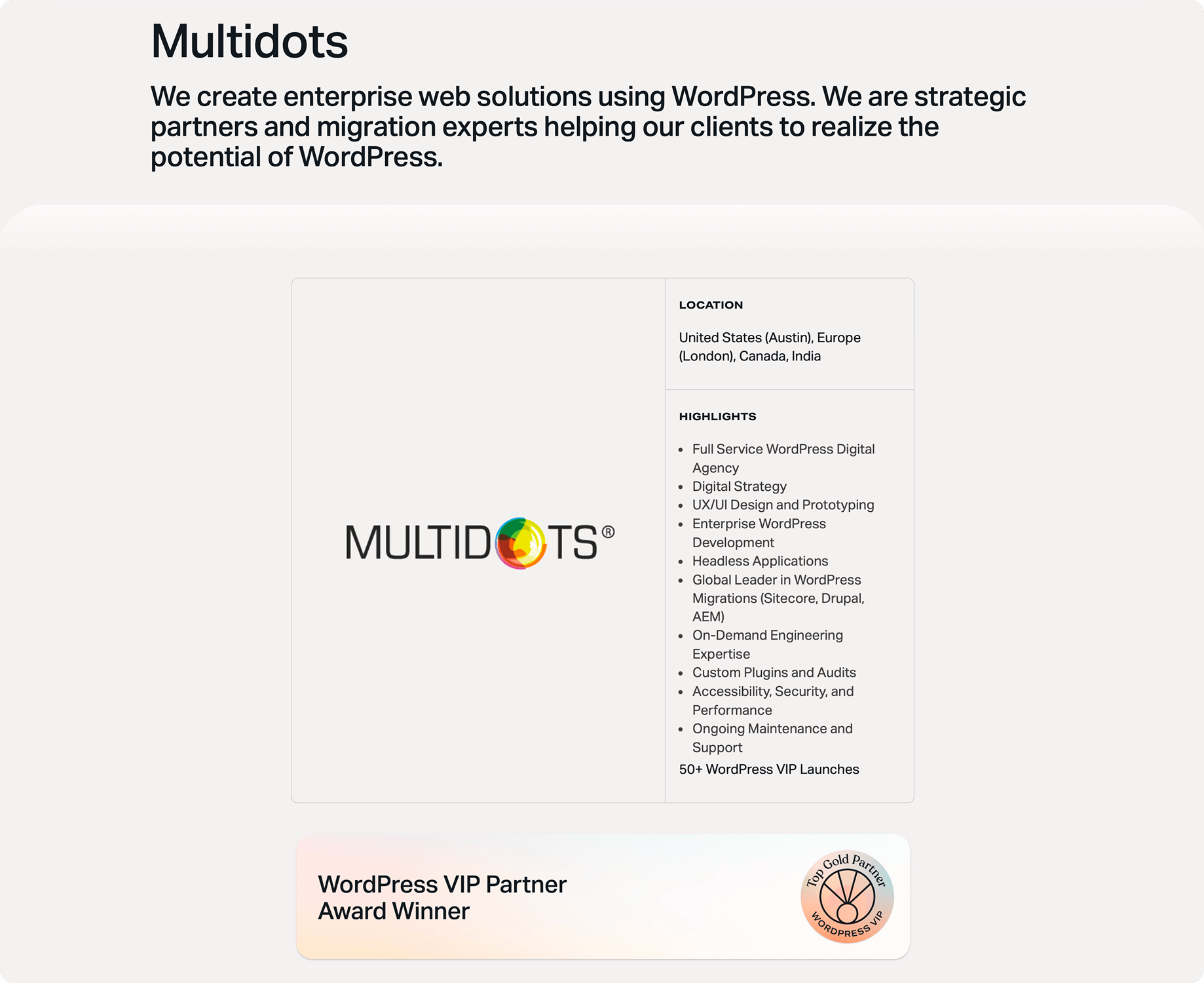
For a broader selection of qualified agencies, you can also explore the WordPress VIP partner directory, which lists vetted agencies with enterprise WordPress expertise.
STEP 2: PRE-MIGRATION PREPARATION
With your high-level strategy in place, it's time to prepare for the actual migration. This preparation phase is crucial for a smooth transition and helps prevent data loss, maintains SEO equity, and ensures all stakeholders are aligned.
2.1 Comprehensive back strategy
First things absolutely first—create comprehensive backups of your AEM environment. This is your safety net should anything go wrong during migration.
Here's how to create thorough backups of your AEM implementation:
- Content Backup: Use CRXDE Lite or AEM Package Manager to export all content including pages, assets, and configurations. Export your content in a structured format that can be parsed during migration.
- Digital Asset Management Backup: Export all media assets from AEM's DAM system along with their metadata, tags, and organizational structure. Ensure you capture asset relationships and usage tracking.
- Configuration Backup: Document and export all AEM configurations including workflows, user permissions, templates, and custom components. This information will be crucial for replicating functionality in WordPress.
- Integration Documentation: Document all current integrations, their configurations, and data flows. This ensures nothing is missed during the WordPress setup.
Here's a step-by-step video guide on creating bulletproof AEM backups before starting your migration:
Remember to test your backups by restoring them to a development environment before proceeding with migration. Store backups in multiple locations including secure cloud storage with encryption enabled.
2.2 Content inventory and audit
A thorough content inventory is essential for understanding exactly what needs to be migrated and how it should be organized in WordPress.
Your content audit should include:
- Content Classification: Identify all content types including pages, blog posts, product information, downloadable resources, and multimedia assets. Understanding your content types helps map them to appropriate WordPress structures.
- Content Quality Assessment: Evaluate content relevance, accuracy, and performance. Migration is an excellent opportunity to clean up outdated or underperforming content rather than carrying it forward to WordPress.
- SEO Value Analysis: Identify your highest-performing content in terms of organic traffic, conversions, and engagement. These pages require special attention during migration to preserve their SEO value.
- Content Relationships: Document how content pieces relate to each other, including cross-references, content hierarchies, and taxonomical relationships. WordPress needs to replicate these relationships for optimal user experience.
- Custom Components: Identify any custom AEM components used in your content and plan how they'll be recreated as WordPress blocks or shortcodes.
Most importantly, use this audit to prioritize content for migration. Not everything needs to move immediately—you can phase migration based on content importance and business impact.
Looking to take control of your content migration?
Use our Content Audit Template to track all your content systematically. This template includes tabs for different content types and fields for organizing, prioritizing, and streamlining every step.

2.3 SEO and Performance Baseline
Before migrating, establish comprehensive benchmarks for your current site's performance and SEO metrics. This baseline helps you measure migration success and identify any issues that need addressing.
SEO Metrics to Capture:
- Organic traffic volumes and trends
- Keyword rankings for important terms
- Page load speeds and Core Web Vitals
- Backlink profiles and domain authority
- Search Console performance data
- Conversion rates and user engagement metrics
Tools for Baseline Creation: Use Google Analytics for traffic and behavior data, Google Search Console for search performance metrics, Screaming Frog for technical SEO audit, PageSpeed Insights for performance benchmarks, and SEMrush or Ahrefs for comprehensive SEO analysis.
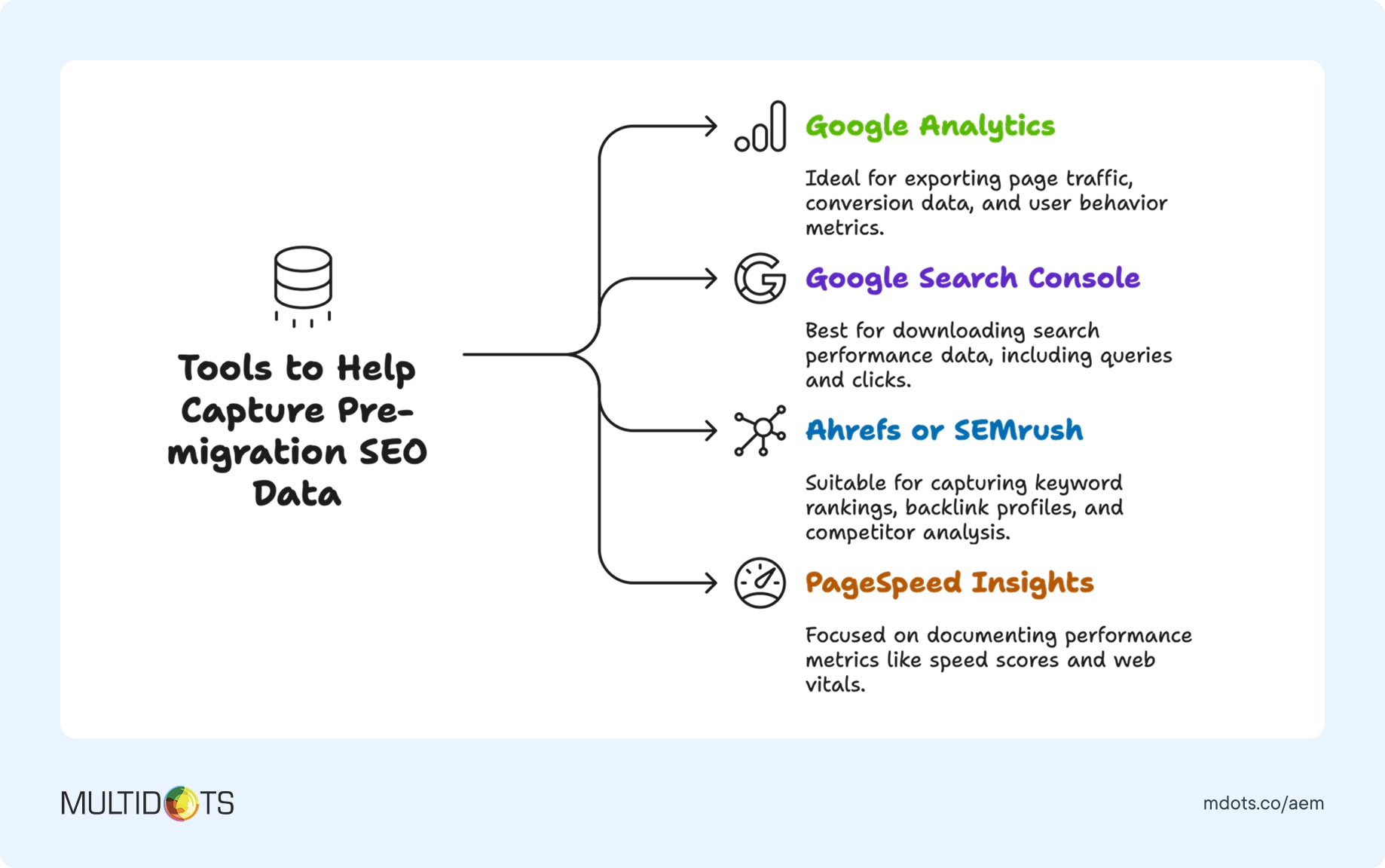
Export all this data before migration begins. Having concrete numbers makes it easier to demonstrate migration success and quickly identify any issues that need addressing post-launch.
2.4 AEM content structure analysis
Understanding how your content is organized in AEM is crucial for planning its WordPress structure. AEM's content architecture differs significantly from WordPress, so this mapping is essential for a successful migration.
- Content Hierarchy Mapping: Document how AEM's content tree structure will translate to WordPress's page hierarchy and navigation structure.
- Taxonomy Translation: Map AEM's tagging and categorization system to WordPress categories, tags, and custom taxonomies.
- Template Analysis: Identify which AEM templates correspond to which WordPress page templates or post types.
- URL Structure Planning: Plan how AEM URLs will map to WordPress URLs, considering SEO implications and user experience.
This analysis helps ensure your WordPress site maintains logical content organization while taking advantage of WordPress's more intuitive content management approach.
Watch this short video on migrating AEM's complex tagging and taxonomy structures to WordPress:
STEP 3: WORDPRESS ENVIRONMENT SETUP
3.1 Architecture decision: traditional vs headless WordPress
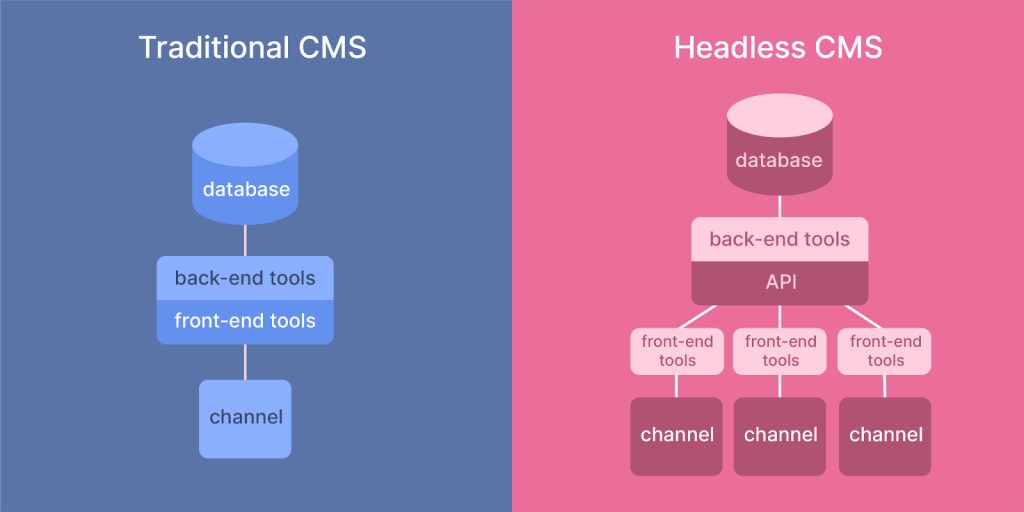
3.2 Multisite vs single site strategy
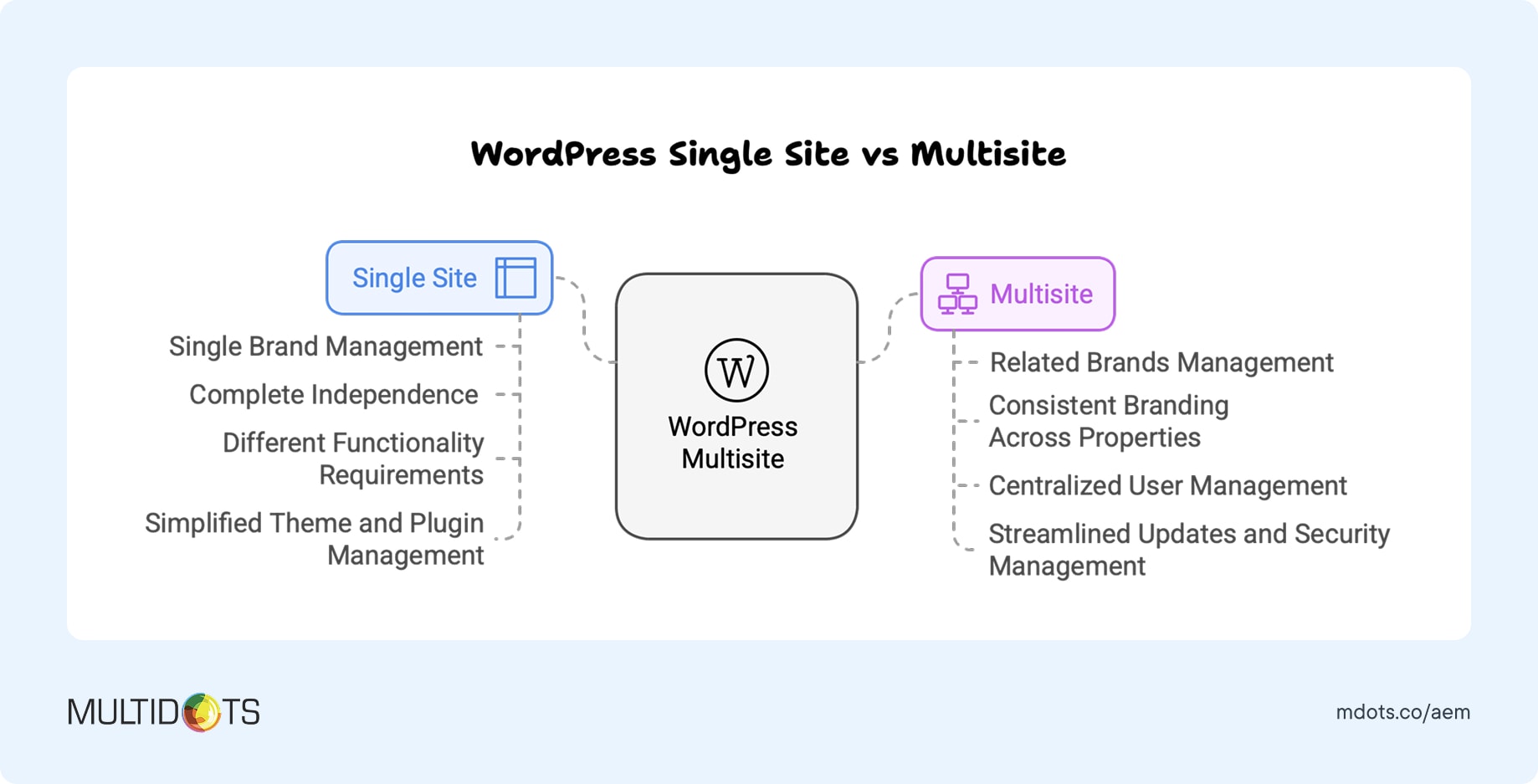
3.3 User roles and workflow configuration
Here's a complete walkthrough on how to seamlessly migrate AEM user roles to WordPress while maintaining security and access control:
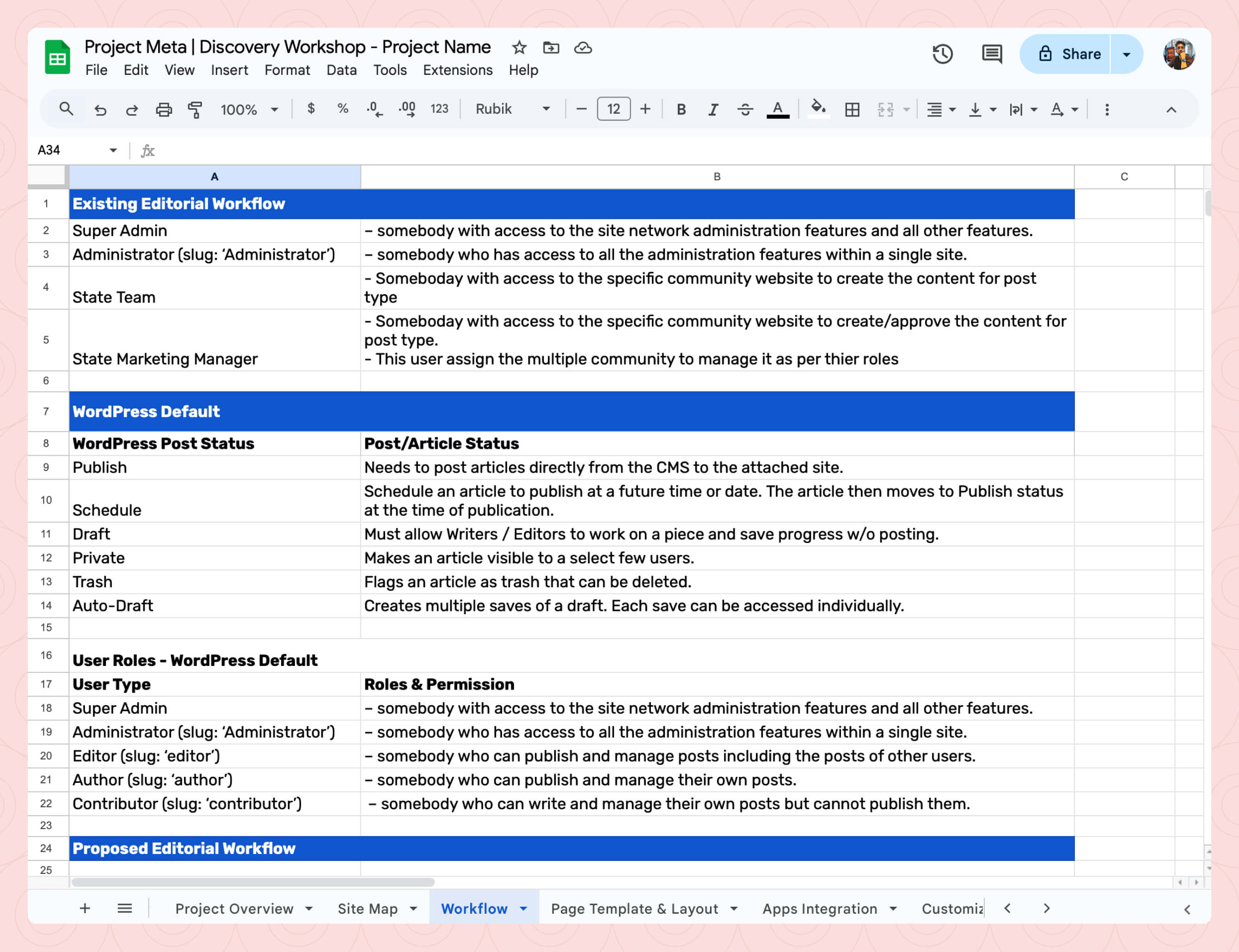
3.4 Custom Gutenberg blocks development

3.5 Essential plugin stack for enterprise
STEP 4: MIGRATION EXECUTION AND LAUNCH
Now comes the exciting part—actually migrating your content and launching your new WordPress site. This phase requires careful coordination and thorough testing to ensure everything works perfectly.
4.1 Content migration process
Content migration from AEM to WordPress involves several technical steps, but with proper planning, it can be surprisingly smooth.
- AEM Content Export: Use AEM's Content Transfer Tool or Package Manager to export content in XML or JSON format. Ensure you capture all metadata, relationships, and custom properties.
- Data Transformation: Convert AEM's content structure to WordPress-compatible format. This often requires custom scripts to map AEM content types to WordPress post types, pages, and custom fields.
- WordPress Import: Use WordPress's built-in import functionality or plugins like WP All Import for bulk content import. Import in phases to maintain control and allow for testing at each stage.
- Content Verification: Systematically verify that all content has been imported correctly, maintaining formatting, links, and media associations.
The key to successful content migration is doing it systematically rather than trying to move everything at once. Start with a small subset of content to refine your process before migrating the entire site.
4.2 Media and digital asset migration
Migrating from AEM's sophisticated DAM system to WordPress requires careful planning to maintain asset organization and accessibility.
- Asset Export and Organization: Export all media assets from AEM DAM with their metadata, tags, and folder structure. Organize assets logically for WordPress import.
- Asset Optimization: Optimize images for web delivery, compress videos for streaming, and ensure all assets meet WordPress requirements for size and format.
- WordPress Media Import: Use plugins like Media Library Assistant or custom scripts to import assets while maintaining organizational structure and metadata.
- CDN Integration: Implement a Content Delivery Network to ensure fast asset delivery globally, often improving performance over AEM implementations.
The goal is to maintain or improve asset discoverability and performance while simplifying management for your content teams.
4.3 URL mapping and SEO preservation
Maintaining SEO equity during migration is crucial for business continuity and requires careful URL mapping and redirect implementation.
- Comprehensive URL Mapping: Document every important URL on your AEM site and map it to the corresponding WordPress URL. Don't forget about assets, documents, and deep-linked content.
- 301 Redirect Implementation: Use plugins like Redirection or custom server-level redirects to ensure all old URLs point to their new WordPress equivalents.
- Metadata Transfer: Ensure all SEO metadata including title tags, meta descriptions, and schema markup transfers correctly to WordPress.
- Search Console Updates: Update your Google Search Console properties and submit new sitemaps to help search engines understand your site's new structure.
Proper SEO preservation often results in improved search performance because WordPress's SEO-friendly structure and faster loading times can boost rankings.
4.4 Pre-launch testing and quality assurance
Thorough testing is essential before taking your new WordPress site live. This comprehensive QA process helps identify and resolve issues before they impact users.
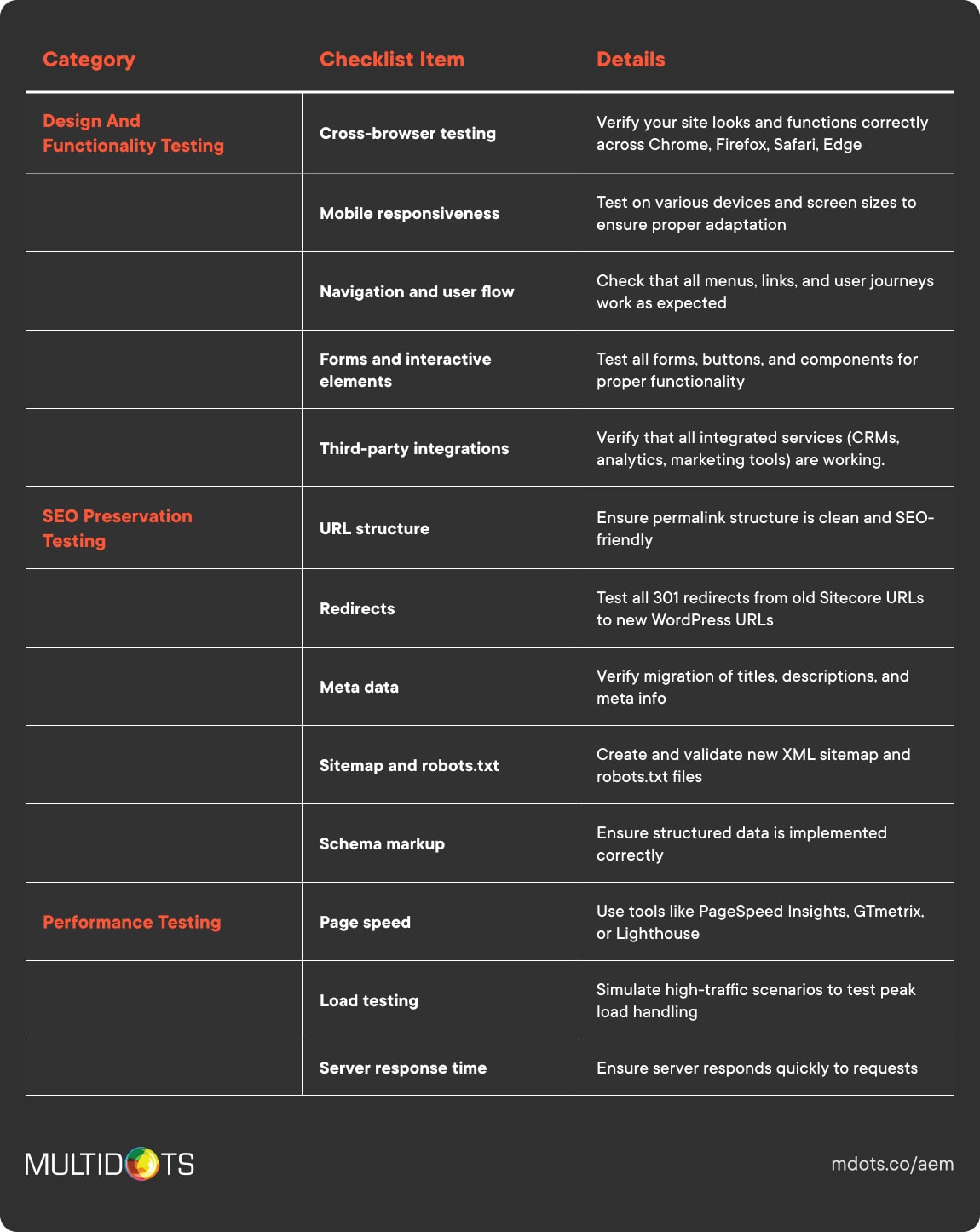
- Functionality Testing: Verify all interactive elements work correctly including forms, search functionality, user registration, and e-commerce features.
- Cross-Browser Compatibility: Test your site across different browsers and devices to ensure consistent experience for all users.
- Performance Testing: Use tools like GTmetrix and Google PageSpeed Insights to verify your WordPress site meets or exceeds your AEM site's performance.
- Security Testing: Run security scans to ensure your WordPress implementation meets enterprise security standards.
- Content Verification: Systematically check that all migrated content displays correctly with proper formatting, working links, and associated media.
- Integration Testing: Verify all third-party integrations function correctly in the WordPress environment.
Testing should involve not just technical verification but also user acceptance testing with actual content creators and end users to ensure the migration meets everyone's needs.
Prepping for launch day?
Here’s a comprehensive deployment checklist we’ve prepared to guide you through the final stages of your AEM to WordPress migration. This checklist ensures a smooth transition by covering everything from pre-deployment preparations, technical checks, SEO preservation, security measures, and post-launch monitoring.
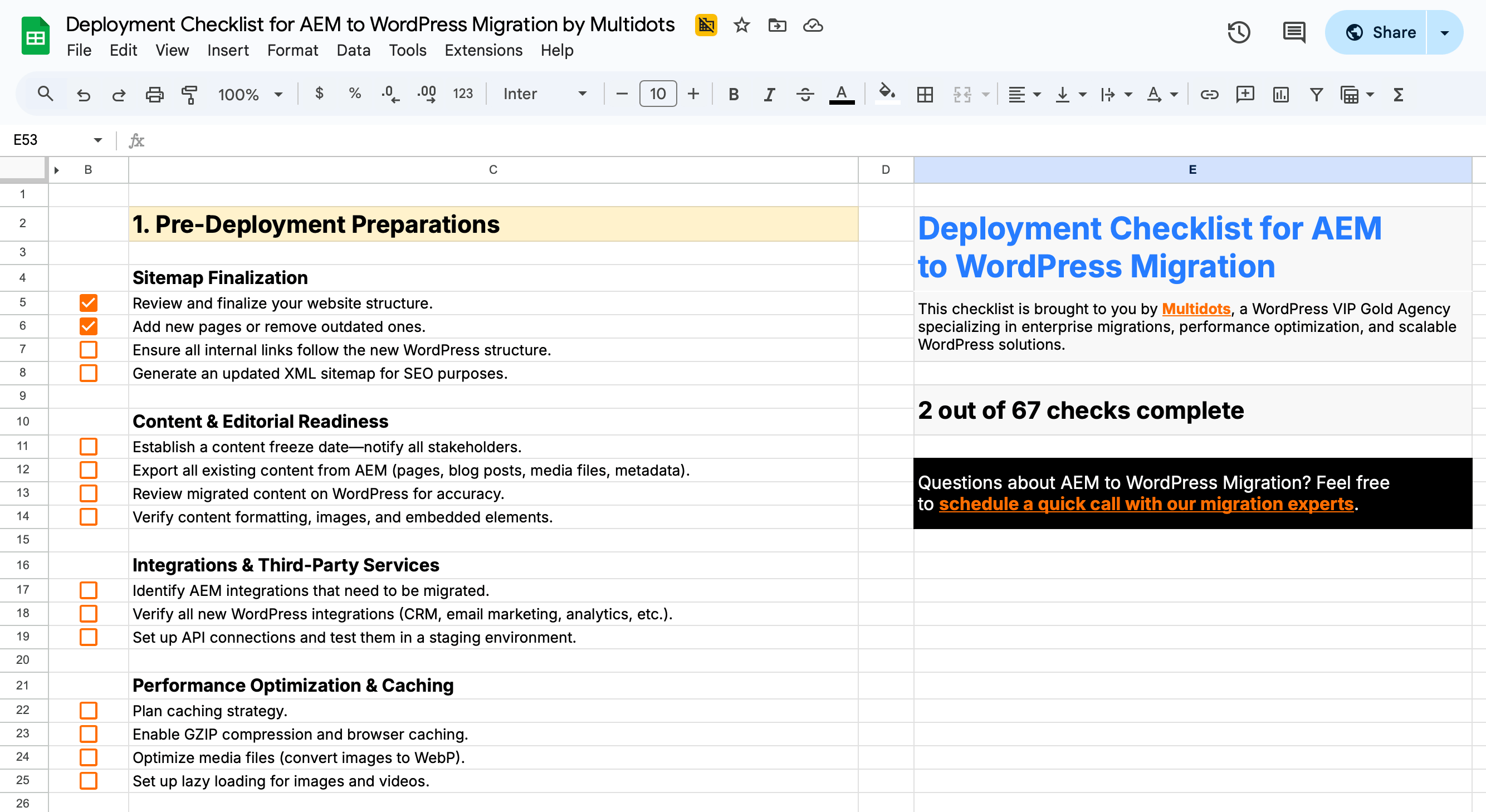
4.5 Go-live strategy and monitoring
The actual launch requires careful coordination to minimize downtime and quickly address any issues that arise.
- Pre-Launch Checklist: Ensure all testing is complete, backups are current, monitoring tools are configured, and support teams are ready.
- DNS Cutover: Plan the switch from AEM to WordPress hosting during low-traffic periods to minimize impact on users.
- Real-Time Monitoring: Monitor site performance, user experience, and any error reports during the first 24-48 hours after launch.
- Issue Response Protocol: Have a clear escalation path for addressing any problems that arise during or immediately after launch.
- Success Metrics Tracking: Monitor key performance indicators to measure migration success including site performance, user engagement, and conversion rates.
Most successful launches are anticlimactic—users don't notice the change except for improved performance and functionality.
STEP 5: POST-MIGRATION OPTIMIZATION AND TEAM TRAINING
Your migration is complete, but the work doesn't stop there. Post-migration optimization and team training are crucial for maximizing your WordPress investment.
5.1 Performance optimization and monitoring
WordPress often performs better than AEM out of the box, but there's always room for optimization.
- Caching Implementation: Configure advanced caching strategies using plugins like WP Rocket or server-level caching to ensure optimal page load times.
- Image Optimization: Implement automated image compression and next-gen format delivery through plugins like ShortPixel or Smush.
- Database Optimization: Clean up your WordPress database regularly and optimize queries for better performance.
- CDN Configuration: Fine-tune your Content Delivery Network settings to ensure global users get the fastest possible experience.
- Monitoring Setup: Implement comprehensive monitoring using tools like New Relic, Pingdom, or WordPress-specific solutions to track performance metrics and identify optimization opportunities.
Most organizations see immediate performance improvements after migrating from AEM, but ongoing optimization ensures you maintain peak performance as your site grows.
5.2 Team training and workflow optimization
Your team's success with WordPress depends on proper training and workflow setup. The good news? Unlike AEM's steep learning curve, WordPress is designed to be intuitive, and most teams achieve proficiency much faster than they expect.
Content creators typically love the transition from AEM to WordPress. The Gutenberg editor feels familiar and responsive, much like working in a modern document editor. Focus training on block-based content creation, reusable components, and media management. Most content creators become more productive in WordPress within their first week, compared to the months of training typically required for AEM proficiency.
For editors and managers, WordPress opens up new possibilities for workflow management and content oversight. Training should cover advanced editorial workflows, user permission management, and content planning tools. The transparency and simplicity of WordPress workflows often surprise teams accustomed to AEM's complex approval processes.
Technical teams benefit from WordPress-specific training even if they're experienced developers. Cover WordPress coding standards, security best practices, and performance optimization techniques. The open-source nature of WordPress means your developers can learn from a vast community and aren't limited by proprietary documentation like they were with AEM.
Creating custom training materials that reference your specific WordPress setup, custom blocks, and organizational workflows accelerates adoption and reduces the support burden on your technical team.
5.3 Long-term success strategy
Your AEM to WordPress migration isn't just about moving platforms—it's about positioning your organization for long-term digital success.
- Content Strategy Evolution: Leverage WordPress's flexibility to experiment with new content formats, interactive elements, and user engagement strategies that weren't practical with AEM.
- Continuous Improvement Process: Establish regular review cycles to assess performance, identify optimization opportunities, and plan feature enhancements.
- Community Engagement: Take advantage of WordPress's massive community for ongoing learning, problem-solving, and staying current with platform developments.
- Scalability Planning: Plan for growth by establishing processes for adding new sites, expanding functionality, and managing increased traffic without the cost constraints of AEM.
The organizations that see the most success after migrating from AEM to WordPress are those that view the migration as a starting point for innovation rather than just a platform change.
STEP 6: ONGOING MAINTENANCE AND MONITORING
Congratulations! Your migration is complete, and your team is trained on the new WordPress platform. Now comes an equally important phase: ensuring your website stays secure, up-to-date, and performs optimally over time.
Unlike AEM's complex maintenance requirements that often demand specialized Adobe-certified professionals, WordPress maintenance is straightforward and cost-effective. However, enterprise sites still require systematic attention to maintain peak performance and security.
6.1 WordPress update management
One of WordPress's biggest advantages over AEM is how simple updates can be. No more waiting months for Adobe's update cycles or dealing with complex version upgrades that require extensive testing and specialized expertise.
Here's how to manage WordPress updates effectively:
- Create a staging environment for testing updates before applying them to your live site. This prevents any potential conflicts from affecting your users and gives you confidence in each update.
- Establish a regular update schedule by checking for updates weekly and applying them monthly during planned maintenance windows. WordPress core updates are typically seamless, but consistency prevents security vulnerabilities.
- Prioritize security updates by applying them immediately when released. WordPress's security team responds quickly to threats, and prompt updates keep your site protected.
- Document your plugin inventory so you know what each plugin does and can identify any redundancies. This prevents conflicts and keeps your site running efficiently.
- Test functionality after updates by running through critical site functions including forms, e-commerce features, and integrations to ensure everything works correctly.
The beauty of WordPress updates compared to AEM is their frequency and simplicity. Instead of major version upgrades that can take months to plan and execute, WordPress updates typically take minutes and rarely cause issues when properly managed.
6.2 Performance and security monitoring
Monitoring your WordPress site isn't just about knowing when it's down—it's about proactively identifying opportunities for improvement and potential security threats before they impact users.
Uptime Monitoring: Services like Pingdom, UptimeRobot, or Jetpack Monitor constantly check if your site is accessible and alert you immediately if issues arise. Most enterprise hosting providers include uptime monitoring, but additional monitoring provides redundancy and detailed reporting.
Performance Tracking: Tools like Google PageSpeed Insights, GTmetrix, and New Relic help track your site's speed and performance over time. WordPress sites typically perform better than AEM implementations, but ongoing monitoring ensures you maintain optimal speed as your content and traffic grow.
Security Monitoring: Solutions like Wordfence, Sucuri, or Jetpack Security provide real-time security monitoring, alerting you to potential threats, failed login attempts, and suspicious activities. Unlike AEM's complex security requirements, WordPress security monitoring is straightforward and highly automated.
Database Health: Regular database optimization prevents performance degradation over time. Plugins like WP-Optimize or WP Rocket include database cleaning features that keep your site running efficiently without the database complexity that often plagues AEM installations.
Analytics Review: Regular analysis of your Google Analytics and Search Console data helps identify performance trends, content opportunities, and technical issues that might need attention.
For enterprise WordPress sites, we recommend implementing a comprehensive monitoring strategy that combines automated tools with regular manual reviews. Set up alerts for critical issues while scheduling weekly reviews of performance metrics and monthly deep-dive analyses.
6.3 Maintenance service options
Even with WordPress's simplified maintenance requirements, having professional support provides peace of mind and access to specialized expertise when you need it most.
What to Look for in WordPress Maintenance Services:
- Proactive monitoring and maintenance rather than just reactive problem-solving. Your maintenance partner should identify and address potential issues before they impact your users.
- Regular performance optimization including caching configuration, database cleanup, and speed optimization to ensure your site continues performing better than your old AEM implementation.
- Security hardening and monitoring with real-time threat detection, malware scanning, and immediate response to security incidents.
- Content and functionality updates to keep your WordPress installation, themes, and plugins current with the latest features and security patches.
- Detailed reporting on work performed, site health metrics, and recommendations for improvements.
- Enterprise-level support with guaranteed response times and direct access to WordPress experts who understand enterprise requirements.
Multidots Maintenance Offerings
At Multidots, we offer comprehensive WordPress maintenance services designed specifically for enterprises that have migrated from complex platforms like AEM.
Our maintenance packages include proactive monitoring and optimization, security hardening and threat response, regular updates with testing protocols, performance optimization and reporting, and dedicated support from WordPress VIP certified experts.
Whether you need comprehensive managed maintenance or specific support for your internal team, we provide flexible options that scale with your needs and budget.
The goal is simple: ensure your WordPress investment continues delivering the performance, security, and reliability advantages that motivated your migration from AEM.
ADDITIONAL RESOURCES
Looking for quick answers or want to take this guide with you? We've got you covered with these helpful resources.
Frequently Asked Questions
-
Enterprise AEM migrations typically take 12-16 weeks, depending on site complexity, content volume, and customization requirements. Simpler implementations can be completed in 8-10 weeks, while highly complex sites with extensive custom development may take 20+ weeks.
-
When done correctly, migration to WordPress often improves SEO performance due to WordPress’s SEO-friendly architecture and faster loading times. We implement comprehensive redirect strategies and preserve all metadata to maintain rankings during transition.
-
Yes, WordPress powers some of the world’s highest-traffic websites. With proper hosting and optimization, WordPress can handle traffic volumes that exceed most AEM implementations while providing better performance and lower costs.
-
Custom AEM components are recreated as WordPress Gutenberg blocks or plugins. This often results in improved functionality and easier content creator adoption while maintaining all essential features.
-
WordPress offers superior integration flexibility, allowing you to choose best-of-breed solutions rather than being locked into Adobe’s ecosystem. Most integrations can be replicated with better performance and lower costs.
-
When properly configured with enterprise hosting and security protocols, WordPress meets the most stringent security requirements. Many Fortune 500 companies trust WordPress with their most critical web properties.
-
WordPress maintenance is typically simpler and less expensive than AEM. The large developer community means abundant resources for support, and updates are generally straightforward with minimal business disruption.
-
Absolutely. Phased migration is often the preferred approach for large enterprise sites. You can migrate sections of your site systematically while maintaining the AEM instance for remaining content until the full migration is complete.
-
Proper migration planning includes staging environments, comprehensive testing, and carefully coordinated launch procedures to minimize downtime. Most migrations experience less than 4 hours of actual downtime.
-
Most organizations see positive ROI within 12-18 months through reduced licensing costs, lower maintenance expenses, and improved operational efficiency. The savings often accelerate in subsequent years as teams become more productive with WordPress.
Feel free to schedule a quick call with our migration expert.
Contact Us